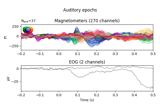mne.preprocessing.regress_artifact¶
-
mne.preprocessing.regress_artifact(inst, picks=None, picks_artifact='eog', betas=None, copy=True, verbose=None)[source]¶ Regress artifacts using reference channels.
- Parameters
- instinstance of
Epochs|Raw The instance to process.
- picks
str|list|slice|None Channels to include. Slices and lists of integers will be interpreted as channel indices. In lists, channel type strings (e.g.,
['meg', 'eeg']) will pick channels of those types, channel name strings (e.g.,['MEG0111', 'MEG2623']will pick the given channels. Can also be the string values “all” to pick all channels, or “data” to pick data channels. None (default) will pick good data channels.- picks_artifactarray_like |
str Channel picks to use as predictor/explanatory variables capturing the artifact of interest (default is “eog”).
- betas
ndarray, shape (n_picks, n_picks_ref) |None The regression coefficients to use. If None (default), they will be estimated from the data.
- copybool
If True (default), copy the instance before modifying it.
- verbosebool,
str,int, orNone If not None, override default verbose level (see
mne.verbose()and Logging documentation for more). If used, it should be passed as a keyword-argument only.
- instinstance of
- Returns
Notes
To implement the method outlined in 1, remove the evoked response from epochs before estimating the regression coefficients, then apply those regression coefficients to the original data in two calls like (here for a single-condition
epochsonly):>>> epochs_no_ave = epochs.copy().subtract_evoked() >>> _, betas = mne.preprocessing.regress(epochs_no_ave) >>> epochs_clean, _ = mne.preprocessing.regress(epochs, betas=betas)
References
- 1
Gabriele Gratton, Michael G. H Coles, and Emanuel Donchin. A new method for off-line removal of ocular artifact. Electroencephalography and Clinical Neurophysiology, 55(4):468–484, April 1983. doi:10.1016/0013-4694(83)90135-9.
